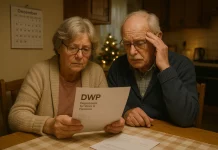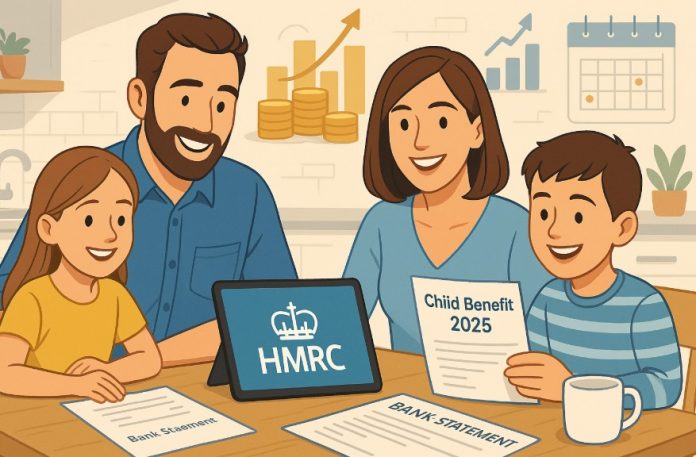Families across the UK will soon feel a welcome boost as Child Benefit payments are set to rise from 7 April 2025. This increase, announced by HM Revenue and Customs (HMRC), comes at a vital time as households navigate rising living costs.
Whether you’re a first-time parent or a seasoned carer, understanding the new rates, updated eligibility criteria, and how to manage your payments digitally is crucial.
In this article, we’ll break down the new Child Benefit rates, explore how to claim using the HMRC app, and explain the latest updates to the High Income Child Benefit Charge – helping families stay financially informed and empowered.
What Are The New Child Benefit Rates For 2025?

Starting from 7 April 2025, the UK government has confirmed that Child Benefit payments will increase. This change is expected to support millions of families by slightly raising the weekly financial assistance they receive for each child.
For the 2025 to 2026 tax year, families will receive £26.05 per week, amounting to £1,354.60 annually for their eldest or only child.
For each additional child, the payment will be £17.25 per week, totalling £897 per year. These payments are disbursed every four weeks directly into the nominated bank account of the claimant.
There is no cap on the number of children parents can claim for. This change reflects the government’s response to rising living costs, aiming to ease the financial pressure on working and middle-income families.
Child Benefit Rates Comparison Table
| Tax Year | Eldest or Only Child | Each Additional Child |
| 2024 to 2025 | £25.60/week (£1,331.20/year) | £16.95/week (£880.20/year) |
| 2025 to 2026 | £26.05/week (£1,354.60/year) | £17.25/week (£897.00/year) |
While the increase may seem small, over the course of a year, it can provide meaningful support when combined with other benefits or allowances available to families.
Who Is Eligible For Child Benefit In 2025?
Child Benefit is available to parents and guardians who are responsible for raising a child. Eligibility is generally straightforward but there are certain conditions that must be met.
The child must be under 16 years of age, or under 20 if they are in full-time education or approved training. The person claiming must live in the UK and be responsible for the care and wellbeing of the child.
Eligibility is not affected by how many children you have. However, income plays a role when it comes to how much benefit a family can effectively keep due to the High Income Child Benefit Charge.
Eligibility also includes those who are fostering or who have adopted children. Importantly, claiming Child Benefit is not only about receiving money. It also secures National Insurance credits, which are essential for future State Pension qualification.
How Can Parents Claim Or Manage Child Benefit Online?

The HMRC app has become the most efficient way for parents and guardians to claim and manage their Child Benefit. With the rise in digital adoption, more than 1.2 million parents have claimed their Child Benefit through the app or HMRC’s digital services since May 2023.
The app allows users to:
- Submit a new Child Benefit claim
- Add additional children to an existing claim
- Update bank details and contact information
- Notify HMRC if a child is staying in full-time education or approved training
- View or print proof of entitlement
A key benefit of using the HMRC app is the speed of processing. Parents often receive a confirmation of their claim within hours and may begin receiving payments in as little as three working days.
The system also provides real-time updates on claim progress and any required documentation, reducing delays that were common with paper-based processes.
The increased convenience has seen the HMRC app used more than six million times in the past year for Child Benefit-related services alone.
What Documents Are Required To Claim Child Benefit?
To claim Child Benefit, parents need to gather and submit specific documents. These documents help HMRC verify the claimant’s eligibility and ensure timely processing of the application.
The required documents include:
- National Insurance number for the claimant and their partner (if applicable)
- Bank account details where the benefit will be paid
- The child’s original birth or adoption certificate
If the child was born outside the UK, additional documents are necessary:
- Child’s original birth or adoption certificate
- Passport or official travel document of the child
All documents must be accurate and up to date. Any discrepancies can delay the application process. It is advisable to keep digital or scanned copies when submitting forms online.
Parents should also ensure that any changes in circumstances, such as address or banking information, are promptly updated through the HMRC app or website.
It’s important to note that Child Benefit claims can only be backdated for up to three months. Therefore, applying promptly after a child’s birth or adoption is crucial to ensure that no benefits are missed.
How Does The High Income Child Benefit Charge Work In 2025?
The High Income Child Benefit Charge, commonly referred to as HICBC, is a tax that affects individuals or households where the income of one partner exceeds a specific threshold.
From 6 April 2024, the government raised this threshold from £50,000 to £60,000. The charge increases gradually and is fully applied once income reaches £80,000.
For those earning between £60,000 and £80,000, a portion of the Child Benefit is effectively reclaimed through the tax system. The higher earner in the household must pay this charge, regardless of who is receiving the benefit.
This tax charge is calculated as one percent of the Child Benefit for every £200 of income over £60,000. At £80,000, the charge equals the total amount received in Child Benefit.
However, families can still choose to claim the benefit and repay it via tax, or opt out of payments altogether while retaining National Insurance credits.
HMRC provides a Child Benefit tax calculator to help families estimate their income-related charge and decide on the best course of action. The tool is especially useful for households where income fluctuates or where one partner’s income might exceed the threshold mid-year.
Can Families Pay The Child Benefit Tax Through PAYE?

Beginning in the summer of 2025, the government will roll out a new option allowing families to pay the High Income Child Benefit Charge directly through their PAYE tax code.
This change is designed to simplify the reporting process and eliminate the need for affected individuals to submit a Self Assessment tax return.
The PAYE option will be especially useful for employed parents who may not otherwise need to file a tax return. It offers a convenient and less time-consuming method of compliance.
This service will be optional. Those who prefer the Self Assessment route can continue using it. For others, the ability to spread payments automatically through PAYE means fewer deadlines and less paperwork, making it easier to stay on top of tax responsibilities.
HMRC has announced that more detailed guidance and official communication will be shared with affected families closer to the launch date. The update is part of the broader digital transformation in UK tax services, aiming to streamline processes and improve user experience.
How Can Families Restart Child Benefit If They Have Opted Out?
Some families, particularly those affected by the High Income Child Benefit Charge (HICBC), may have chosen to opt out of receiving Child Benefit payments in the past.
However, with recent updates to tax thresholds and the introduction of more flexible digital services, many are reconsidering their decision. Restarting Child Benefit is not only possible but now easier than ever through HMRC’s online platforms.
Reasons Families May Have Opted Out
The primary reason families opt out of Child Benefit is the HICBC, which applies when one partner earns over a certain threshold.
In the past, families earning over £50,000 annually were required to repay some or all of their Child Benefit through their Self Assessment tax return. This often led families to opt out of payments entirely to avoid additional tax responsibilities.
Now, with the threshold increased to £60,000 from April 2024 and a full charge not applying until £80,000, more families may find it financially worthwhile to reclaim the benefit.
How to Opt Back In?
Families can restart their Child Benefit claim through the HMRC app or the official GOV.UK portal. The process typically involves:
- Logging into your HMRC online account
- Selecting your existing Child Benefit claim
- Requesting to restart payments
If the family’s details remain unchanged, reactivation can be processed quickly, often without needing to resubmit supporting documents.
What If Your Income Still Triggers the Tax Charge?
Even if your income remains above the threshold, it is still advisable to claim Child Benefit. Payments can be received and the tax repaid via Self Assessment or, from summer 2025, directly through PAYE. Claiming also ensures you continue to receive National Insurance credits, which count toward your State Pension.
Why Is Claiming Child Benefit Important Beyond The Payments?

While the financial support Child Benefit provides is valuable, the long-term advantages of claiming it extend far beyond weekly or monthly payments.
Many parents are unaware that even if they choose not to receive the actual money due to income-related tax charges, simply making a claim still unlocks essential benefits tied to National Insurance and child welfare.
Securing National Insurance Credits
One of the most critical benefits of claiming Child Benefit is the automatic entitlement to National Insurance (NI) credits.
These credits are vital for individuals who are not working or who earn below the NI contribution threshold, such as full-time parents or carers.
NI credits count towards qualifying years for the State Pension, which requires a minimum number of years to receive the full amount.
By claiming Child Benefit, even without receiving payments, parents can protect their long-term financial future. Missing out on NI credits can result in a reduced pension in later life, so it’s essential to stay enrolled in the system.
Automatic National Insurance Number for Children
Another long-term advantage is that a child who is registered for Child Benefit will be automatically issued a National Insurance number shortly before they turn 16. This streamlines their future interaction with the tax and employment system, as they will not need to apply manually.
Proof of Entitlement for Other Services
The Child Benefit award notice also serves as official proof of entitlement, which can be required when applying for:
- School placements
- Housing benefits
- Travel discounts
- Student funding
Parents can now download or print this proof instantly using the HMRC app, making access to related services faster and more efficient.
Claiming Child Benefit is not just about receiving money now — it’s a strategic step in ensuring long-term security for both parents and children.
Conclusion
The Child Benefit increase in 2025 is a powerful reminder of how small changes can make a big difference.
With higher rates, a more inclusive income threshold, and streamlined digital access via the HMRC app, families across the UK are better positioned to manage their finances.
Whether you’re welcoming a newborn or supporting a teen in further education, staying informed and making use of all available tools ensures you maximise the support you deserve.
FAQs About Child Benefit Increase 2025
How Long Does It Take To Receive Child Benefit After Claiming?
Most claims are processed within three weeks, but claims via the HMRC app can be completed in as little as three days.
Can I Claim Child Benefit If My Income Is Over £60,000?
Yes, but the High Income Child Benefit Charge will apply. It’s still worth claiming for the National Insurance credits and auto-enrolment for your child’s NI number.
Can Both Parents Claim Child Benefit?
No, only one person per household can receive Child Benefit for each child.
What Happens When My Child Turns 16?
Child Benefit usually ends on 31 August after the child turns 16, unless they remain in approved education or training, in which case you must inform HMRC.
Can I Receive Child Benefit If I Live Abroad?
In some cases, yes – particularly within the European Economic Area (EEA) or Switzerland. Special rules apply, so contact HMRC for eligibility.
What Is The Best Way To Prove I Receive Child Benefit?
Use the HMRC app or GOV.UK to download and print your award notice. This can be used as official proof for other services.
Can I Use A Child Benefit Calculator To See What I’ll Get?
Absolutely. HMRC provides a Child Benefit calculator to help families estimate their payments and HICBC, making financial planning easier.





























